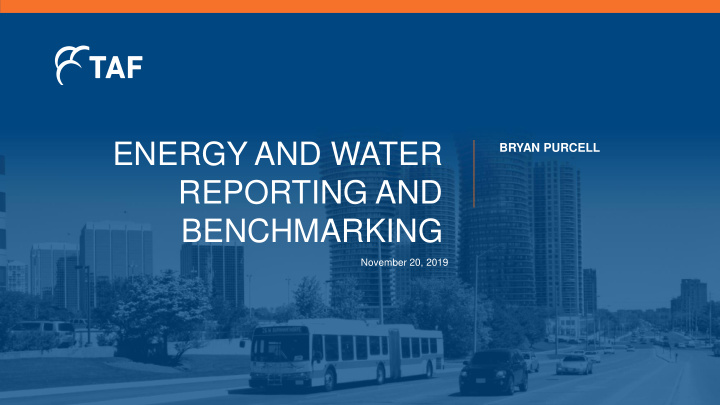



ENERGY AND WATER BRYAN PURCELL REPORTING AND BENCHMARKING November 20, 2019
REDUCING CARBON IN THE REGION Founded in 1991, The Atmospheric Fund (TAF) invests in urban climate solutions to reduce carbon emissions and air pollution.
AGENDA 1. What is EWRB 2. Benefits of EWRB 3. Why EWRB is an important tool 4. Background on the current regulatory details 5. New proposal from province 6. TAF’s concerns about the new proposal 7. Group discussion & Next steps 3
ENERGY AND WATER REPORTING AND BENCHMARKING (EWRB) – O. REG 506/18 • Requires buildings to report energy use, water use, and carbon emissions • Cover most privately owned buildings >50K ft2 • Exemptions for data centres, television studios, trading floors, and some industrial facilities. • Broader public sector covered by separate regulation • Requirements phased in over time, beginning with largest facilities • One-year grace year before data becomes public 4
PHASE IN SCHEDULE The program is currently in Year 2 of a three-year rollout. Year Non-Residential Buildings Multi-Residential Buildings Year 1 250,000 ft2 and up (2017 data in 2018) Year 2 100,000 ft2 and up 100,000 ft2 and up (2018 data in 2019) Year 3 50,000 ft2 and up 50,000 ft2 and up (2019 data in 2020) 5
BENEFITS OF EWRB Benchmarking policies generate significant environmental, social, and economic benefits. 6
ENVIRONMENTAL BENEFITS OF EWRB • GHG Reduction • Estimated potential to avoid more than 1,000,000 TCO2e/year when fully implemented (GTHA) • Air Quality • Outdoor air pollution from energy use in buildings accounts for 190 premature deaths and 400 hospitalizations every year (Toronto) 7
SOCIAL BENEFITS OF EWRB • Housing affordability • Energy & utilities account for approximately one-third of operating expenses for condo and apartment buildings • Improved energy performance = improved housing affordability • Consumer protection • Buying a condo is an enormous financial commitment, but consumers have little information about energy performance • EWRB makes information about a building’s energy performance transparent, allowing would-be buyers or lessees to factor into purchase decisions • Investor protection • Real-estate investors lack information about the energy performance of buildings they may consider buying or leasing space in • EWRB provides investors with accurate info on building performance, protecting investors and creating stronger market pressures for efficiency 8
ECONOMIC BENEFITS OF EWRB • Green jobs • Stimulate additional investment in energy upgrades • Create and sustain employment in skilled trades • Estimated potential for adding up to 10,000 person years of employment by 2035 (Toronto) • Energy savings • Potential cumulative energy savings of $1.9B by 2035 (Toronto) • International competitiveness • Enhances energy productivity • Makes the region a more affordable place to live, work and invest 9
WHY EWRB IS AN IMPORTANT TOOL • Policy design • Achieving 2030 and 2050 GHG targets will require bold new policies in future • EWRB provides detailed picture of building energy performance and how it changes geographically, by sector, and over time, informing policy design • Program targeting • Allows programs, incentives, or financing to be targeted directly at the worst performing buildings, saving time and money and improving results • District energy and community energy planning • Achieving 2050 targets will require energy planning on neighbourhood and district scales • Building performance database allows optimization of district energy and sustainability infrastructure at the community level, zoning and planning decisions, etc. 10
NEW PROPOSAL FROM PROVINCE The Ministry of Energy, Northern Development and Mines has proposed to amend O.Reg. 506/18 to exempt buildings under 100,000 ft2. The rationale for the proposed amendment is to reduce compliance costs on businesses by an estimated $300/year. The deadline to submit comments is December 12 . 11
TAF’S CONCERNS ABOUT THE NEW PROPOSAL • Buildings under 100,000 ft2 account for 55% of the buildings that were expected to participate in the program • The proposed changes could reduce the impact of the policy by 38%, equivalent to more than 428,000 TCO2e/year when fully implemented • Lack of access to data is a key barrier to community energy planning, policy and program design, and growing investment in energy efficiency 12
DISCUSSION AND NEXT STEPS CONSULTATION DEADLINE: DECEMBER 12 CONSULTATION LINK: HTTPS://WWW.ONTARIOCANADA.COM/REGISTRY/VIEW.DO?LANGUAGE=EN&POSTINGID=30347 13
THANK YOU BRYAN PURCELL 75 Elizabeth Street, Toronto ON M5G 1P4 bpurcell@taf.ca | taf.ca
Recommend
More recommend